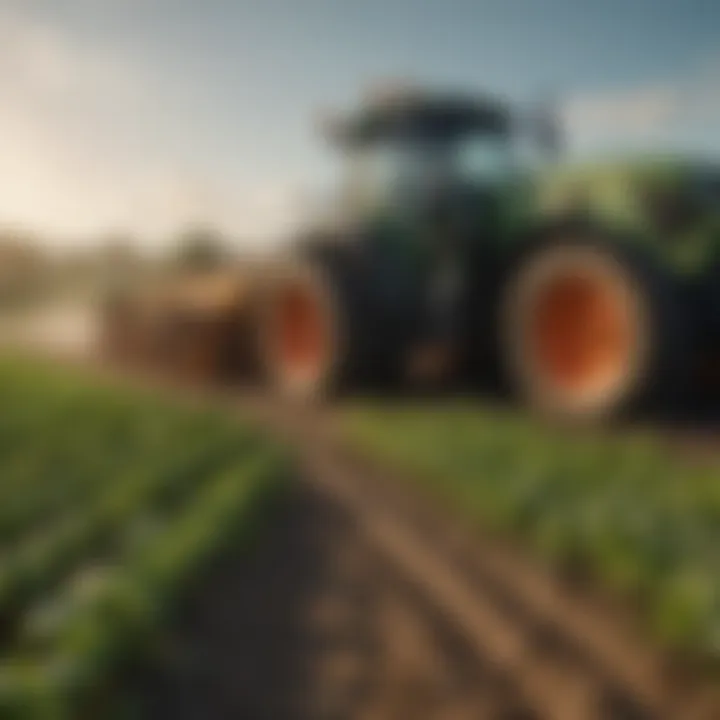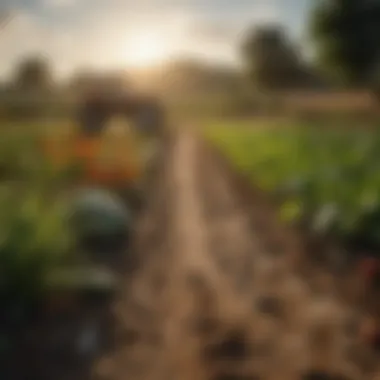Exploring Sustainable Farming Practices and Principles


Intro
Sustainable farming is more than just a buzzword; it’s a critical response to the growing environmental challenges we face today. As the world population surges and climate change intensifies, the agriculture industry must adapt. This adaptation doesn’t just involve finding new ways to grow food but also rethinking our relationship with the land, water, and communities that support us. In this exploration, we will unpack the principles and practices of sustainable farming, shedding light on its significance in preserving our ecosystems while addressing food security.
Topic Overview
Definition and Importance
At its core, sustainable farming refers to agricultural practices that prioritize ecological balance, economic viability, and social equity. It is about harnessing the land's potential while ensuring that future generations inherit a healthy environment. For farmers, this means employing techniques that reduce dependence on chemical fertilizers and pesticides, thereby promoting soil health and biodiversity. The importance of sustainable farming cannot be overstated, as it addresses pressing issues such as:
- Soil degradation
- Water scarcity
- Loss of biodiversity
- Climate change effects
By prioritizing these aspects, sustainable farming creates a resilient agricultural system that supports both current and future needs.
Brief History and Evolution
The concept of sustainable farming is not entirely new. Its roots trace back to traditional agricultural practices that were inherently sustainable, relying on crop rotation, organic amendments, and polyculture. However, the post-World War II agricultural boom introduced synthetic chemicals and intensive farming practices that prioritized short-term yields over long-term health of the ecosystem.
In the 1980s and 90s, a shift began to take place as awareness grew regarding the negative impacts of conventional farming. The sustainability movement gained traction, leading to the adoption of practices that aligned with ecological principles. Significant milestones include:
- 1977: The establishment of the first International Conference on Environmental Education.
- 1986: The publication of the Brundtland Report, which highlighted sustainable development.
- 2005: The introduction of the Millennium Development Goals emphasizing sustainability in agriculture.
This evolution illustrates an ongoing journey towards integrating sustainable practices into mainstream agriculture, even as new challenges arise.
Key Techniques and Innovations
Sustainable Farming Practices
To achieve sustainability, farmers have turned to various techniques that are as diverse as the ecosystems they nurture. These include:
- Crop Rotation: Alternating crops to enhance soil fertility and reduce pests.
- Agroforestry: Integrating trees with crops to enhance biodiversity and reduce erosion.
- Cover Cropping: Planting cover crops to protect soil and suppress weeds during off-seasons.
- Organic Farming: Using natural fertilizers and pest control methods to maintain soil health.
Advanced Agronomic Technologies
Innovations in technology also play a vital role in sustainable farming. Developments like precision agriculture, using data and analytics to optimize inputs and outputs, help farmers achieve better results with fewer resources. Techniques such as:
- Drones: Monitoring crop health and determining the precise application of fertilizers.
- Soil Sensors: Providing real-time data on moisture and nutrient levels, allowing for smarter irrigation.
- Biotechnology: Developing genetically modified crops that require less water and resist pests without chemicals.
These advanced agronomic tools enable farmers to use fewer resources while maximizing productivity and minimizing environmental harm.
Practical Applications
Step-by-Step Guides
Implementing sustainable farming practices might seem daunting, but breaking it down into manageable steps can facilitate the process. Here’s a simplified approach:
- Assess your current practices: Identify areas where improvements can be made.
- Research sustainable methods: Learn about techniques that work best for your region and crops.
- Start small: Implement one or two practices, such as crop rotation or cover cropping, to observe results.
- Monitor progress: Evaluate the impact of changes on crop yield and soil health.
- Scale up: Once you see positive results, expand sustainable methods across your farm.
Case Studies or Real-World Examples
One notable example of sustainable farming is the operation run by the Rodale Institute in Pennsylvania, which has demonstrated organic practices can yield results comparable to conventional farming. Their initiatives include:
- Research on organic farming, providing valuable data to the agricultural community.
- Training programs for farmers, helping them transition to sustainable practices.
This case illustrates not only the success of sustainable techniques but also emphasizes the importance of education in promoting these methods.
"Sustainable farming is not just a trend; it's a proactive response to a planet in need of care."
In summary, understanding and implementing sustainable farming principles is crucial in today's agriculture. By highlighting techniques, innovations, and practical applications, we can pave a way toward a more resilient and equitable food system.
Prologue to Sustainable Farming
Sustainable farming embodies a proactive approach to agriculture that seeks to balance environmental health, economic profitability, and social equity. This intertwining of ecological and economic goals is not merely an ideal but a necessity in today’s fast-paced world. As global populations swell and climates shift, traditional farming methods are struggling to keep pace with the challenges that arise. This is where sustainable practices take center stage, offering tangible solutions that secure food sources while preserving the planet.
The importance of sustainable farming becomes evident when considering the delicate balance of ecosystems. Unsustainable practices lead to soil degradation, water scarcity, and loss of biodiversity. Conversely, by adopting sustainable farming techniques, farmers can revitalize their land, utilize resources more prudently, and promote the wellbeing of their communities.
Why Sustainable Farming Matters
Sustainable farming isn’t just about growing food; it's about nurturing the environment. It promotes practices that help:


- Soil Health: Practices like cover cropping and reduced tillage hold the soil together and increase its fertility.
- Water Efficiency: By utilizing techniques such as drip irrigation, farmers can significantly reduce water waste.
- Biodiversity: Diversifying crops not only mitigates risks associated with pests but also strengthens the resilience of farming systems.
- Community Engagement: Emphasizing fair labor practices and local community support fosters economic stability in rural areas.
The thread of sustainability weaves through the entire agricultural system. In the face of climate change and fluctuating market demands, transitioning towards sustainable practices is not only wise but imperative for future generations.
"Sustainable farming is less of a trend and more of an essential framework that could dictate the future of food security globally."
The exploration of sustainable farming in this article aims to dissect its principles, techniques, impacts, and challenges. With insights from both historical context and modern-day innovations, we can paint a clearer picture of how sustainable farming can be a pathway to a healthier future for everyone.
Key Principles of Sustainable Farming
Sustainable farming is not a fly-by-night trend; it's a robust approach rooted in several core principles. These principles shape how agriculture can operate harmoniously with nature, ensuring that farming practices not only fulfill the needs of the present but also maintain resources for future generations. The importance of these principles lies in how they interlink environmental health, economic viability, and social equity, forging a holistic framework for responsible agriculture.
Environmental Stewardship
Conservation of Resources
Conservation of resources is at the heart of sustainable farming. It focuses on minimizing waste and optimizing the use of vital resources like water, soil, and energy. This not only enhances the efficiency of farming operations but also protects the natural environment. A key feature of this approach is the adoption of practices such as rainwater harvesting and precision irrigation. These methods allow farmers to get the most out of the resources they have. However, one must consider that while these methods require initial investment, the long-term savings and sustainability benefits far outweigh those costs. They prevent depletion, ensuring better yields down the road.
Biodiversity Maintenance
Biodiversity maintenance is another facet that deserves attention in sustainable farming. A diverse ecosystem supports a variety of crops and animals, leading to healthier soil and enhanced resilience against pests. This principle underlines the idea that farms should resemble natural ecosystems, filled with various species rather than monocultures. While this diversity tends to boost resilience, it can also come with challenges, such as increased complexity in management. Yet, this complex web contributes remarkably to the farm's sustainability.
Pollution Reduction
Then we have pollution reduction, which targets minimizing chemicals and harmful inputs that can degrade soil and water quality. Sustainable farms often utilize organic fertilizers and bio-pesticides, which are less harmful to the environment. The key here is that reducing pollution not only aids in protecting local ecosystems but also helps in ensuring the safety of food products. One unique feature of this principle is how it fosters collaboration with local communities, often leading to broader public engagement in environmental stewardship. Despite these advantages, transitioning to practices that minimize pollution can sometimes face resistance due to habit or economic concerns.
Economic Viability
Profitability Considerations
Profitability in sustainable farming is not just about balance sheets. It involves a nuanced understanding of how to make farming a viable long-term business without compromising ecological and social constructs. Successful sustainable farmers often find ways to blend ecological practices with market demands. A unique aspect of this is the ability to sell directly to consumers, which can often yield higher profit margins. However, farmers must keep in mind that they might face challenges in competing with conventional farming prices. Navigating these aspects is vital in realizing economic sustainability.
Sustainable Market Practices
Sustainable market practices refers to how farmers sell their produce while adhering to sustainability principles. For instance, focusing on local markets can reduce carbon footprints and create community ties. This trend toward community-supported agriculture (CSA) has grown immensely, making it a popular choice among farmers. However, developing these markets may require an upfront investment in marketing and education efforts. Ultimately, the long-term stability and patronage these practices nurture can make them worth the effort.
Social Equity
Community Engagement
Community engagement serves as a cornerstone to social equity within sustainable farming. It's about actively involving local communities in farming decisions, creating a stronger bond between farmers and consumers. This inclusivity not only builds trust but also ensures that farming practices reflect local needs and values. Engaged communities often provide invaluable support through local resources and knowledge. However, fostering this engagement demands time and commitment on the part of farmers, which can be challenging in bustling agricultural environments.
Fair Labor Practices
Fair labor practices highlight the respect and protection of workers involved in agriculture. This principle is crucial in ensuring that everyone in the supply chain is treated justly and compensated fairly. Implementing fair labor practices can enhance worker morale and productivity, directly benefiting the farming operation by reducing turnover rates and enhancing loyalty. Yet, as with many aspects of sustainable farming, no good comes without challenges. Maintaining compliance and establishing a solid groundwork for these practices takes diligence. The investments pay off in creating a supportive and equitable farming atmosphere.
These key principles of sustainable farming underscore its holistic nature, integrating the well-being of the environment, economy, and society into a compelling picture of the future of agriculture.
Sustainable farming, with its focus on key principles, presents a path forward that could lead to a vibrant and resilient agricultural sector, contributing to the long-term health of our planet.
Sustainable Farming Techniques
Sustainable farming techniques play a pivotal role in minimizing the environmental impacts of agriculture while enhancing productivity and resilience. These methods focus not just on yield but on fostering ecosystems that maintain balance. By integrating ecological principles into farming, producers can combat climate change, restore soil health, and support biodiversity. Here's a closer look at the various techniques that define sustainable farming and how they work.
Crop Rotation
Crop rotation is the practice of alternating the species of crops grown on a particular piece of land over seasons. This ancient method doesn't just help prevent soil depletion, it also disrupts the life cycles of pests and diseases. For instance, planting legumes after heavy feeders like corn can replenish nitrogen in the soil, enhancing fertility.
Benefits of Crop Rotation:
- Reduces the need for chemical fertilizers.
- Promotes biodiversity in the field.
- Saves water by retaining moisture in the soil.
Consider the challenge that farmers face with pests. When a single crop is grown repeatedly, pests that rely on that crop can thrive. Crop rotation breaks this cycle, making it harder for these pests to establish themselves. Often, farmers who practice crop rotation report healthier crops and reduced need for pesticides.
Agroforestry
Agroforestry is an integrated approach that combines agriculture and forestry to create more sustainable and productive land-use systems. This technique involves growing trees alongside crops or livestock, leveraging the advantages that each can bring to the other. Trees can act as windbreaks, provide shade, and even yield products like fruits, nuts, or wood.
Benefits of Agroforestry:
- Enhances biodiversity and habitats.
- Improves soil structure and reduces erosion.
- Provides farmers with diverse income streams.


The inclusion of trees can have profound impacts on water conservation as well. They help in maintaining moisture levels while providing habitats for beneficial organisms that can manage pests naturally, thereby promoting a healthier ecosystem.
Organic Farming Practices
Organic farming practices revolve around growing crops without synthetic fertilizers, pesticides, or genetically modified organisms. This method emphasizes the use of natural inputs like compost and biological pest controls.
Key Elements of Organic Farming:
- Fertility management through compost and crop residues.
- Rotation of crops to maintain soil health.
- Use of natural pest predators instead of chemicals.
For consumers and farmers alike, organic farming represents a commitment to sustainability. It's a way for producers to reconnect with the land while also putting out a product that can attract a segment of health-conscious consumers willing to pay a premium.
Permaculture Principles
Permaculture is more than just a set of techniques; it's a whole design philosophy that seeks to create agricultural systems that mimic natural ecosystems. This practice is about creating self-sustaining and resilient agricultural environments through careful design and planning.
Core Principles of Permaculture:
- Observe and interact with the environment to understand it better.
- Use renewable resources and services.
- Produce no waste by recycling and repurposing materials.
By imitating nature, permaculture can lead to farms that are resilient against climate variability. For instance, permaculture systems might incorporate rainwater harvesting techniques or perennial crops that require less tillage and fewer inputs.
"Sustainable farming techniques highlight the integration of environmental principles into agricultural practices, leading to a healthier planet and communities."
Through the lens of these sustainable farming techniques, it's clear that adopting innovative approaches can reap extensive rewards. Not only do they serve to protect the environment, but they also empower farmers and local communities to thrive economically and socially.
The Impact of Sustainable Farming
The significance of sustainable farming cannot be overstated; it plays a vital role in ensuring a balanced ecosystem while addressing the urgent needs of our growing population. This section seeks to unwrap the various ways sustainable farming practices contribute to the health of our environment and food security. As we dive deeper, you'll see how these practices intertwine with pressing global issues—think pollution, biodiversity loss, and equitable food distribution.
On Environmental Health
Sustainable farming is a game changer for environmental health. It nurtures the land and helps maintain the delicate balance within ecosystems. Let's break down the core components that underline this connection, starting with soil health.
Soil Health
Soil health is the backbone of sustainable farming. A vibrant, healthy soil comprises diverse organisms and organic matter that support plant life. This is crucial because good soil structure allows for better absorption of water and nutrients. A characteristic that makes it so appealing is that it not only promotes higher crop yields but also fosters resilience against pests and diseases. When farmers engage in practices such as cover cropping and reduced tillage, it results in an enriched soil that can sustain crops for longer durations.
A unique feature of healthy soil is its capacity to store carbon, which is essential in combating climate change. The advantage here is double-edged: not only do farmers benefit from better productivity, but they also contribute positively towards reducing atmospheric CO2 levels.
Water Conservation
Water conservation is another pivotal aspect tied closely to sustainable farming. It’s not just about saving water; it’s about using it wisely. The rising global population means an increasing demand for water, and inefficient farming practices can lead to significant wastage. Sustainable methods such as drip irrigation or rainwater harvesting systems allow farmers to use water more effectively while still supporting the crops.
The key characteristic of water conservation techniques is their ability to enhance crop resilience, especially during dry spells. What makes it particularly favorable is that it can significantly reduce operational costs for farmers in the long run. However, implementing these systems may require initial investment, which could be a barrier for smaller operations, but the long-term benefits often outweigh the initial hurdles.
Carbon Sequestration
Carbon sequestration refers to the process through which carbon dioxide is captured and stored—essentially a natural way to mitigate climate change. In sustainable farming, methods like agroforestry and no-till farming are pivotal. By incorporating trees and minimizing disruption to the soil, farmers can enhance their land's ability to capture and store carbon.
The unique benefit of carbon sequestration is it contributes to climate stability while simultaneously improving soil structure. It’s a beneficial strategy that not only aids in reducing greenhouse gases but also improves soil fertility. The downside? It's a nuanced process that relies heavily on specific agricultural practices, making it somewhat complex to adopt universally across different farming contexts.
On Food Security
Shifting focus, sustainable farming directly impacts food security too. It doesn't merely create food; it ensures that this food is produced in a manner that can endure the test of time. Embedding sustainability in farming practices not only bolsters local food systems but also contributes to global food security.
- Increasing Crop Diversity: Implementing diverse cropping systems aids in reducing vulnerability to pests and market fluctuations.
- Supporting Local Economies: When sustainable methods are employed, local economies thrive as these practices often require local labor.
In summary, the positive impacts of sustainable farming resonate across environmental health and food security. Understanding how these elements contribute to a resilient agricultural system is fundamental for farmers and enthusiasts alike.
Challenges to Implementing Sustainable Farming
Sustainable farming holds promises of healthier ecosystems and economic benefits, but the road to adopting these methods is riddled with challenges. Understanding these obstacles is crucial for anyone interested in promoting sustainable practices within agriculture. By recognizing hurdles, we can better strategize to create effective solutions, ensuring that sustainable practices become the norm rather than the exception.
Financial Constraints
In the realm of sustainable farming, finances often serve as a significant barrier. Farmers are constantly walking a tightrope, trying to balance expenses with profit. Shifting to sustainable methods can demand a hefty initial investment—think organic seeds or upgraded irrigation systems. For many, the cost outweighs the perceived benefits, especially when traditional farming practices promise shorter-term gains.
- Resource Allocation: Sustainable techniques might require specific equipment, which can strain already tight budgets.
- Market Fluctuations: The price of sustainably grown products can fluctuate, making it difficult to predict profitability.
Additionally, transitioning from conventional methods can take time. Farmers might find themselves in a bit of a pickle, investing in sustainable practices only to see a lag in rewards. This lag can be frustrating and can discourage adoption.


Knowledge Gaps
The chasm between knowledge and practice cannot be overlooked. Many farmers want to adopt sustainable methods, yet they often lack access to information on best practices. This gap can stem from a variety of sources:
- Training Opportunities: Many rural areas do not have access to workshops or seminars that focus on sustainable techniques.
- Research Availability: Sometimes, credible research on sustainable methods is buried under layers of information, making it hard for farmers to find what truly matters.
The journey from curiosity to implementation often turns into a winding road of misinformation and confusion. A farmer may stumble upon conflicting advice, making it challenging to figure out the most effective step forward. In a world where farming practices are evolving rapidly, keeping up with the trends is paramount for success.
Policy and Regulation Hurdles
Policies surrounding agriculture play a crucial role in shaping the landscape for sustainable practices. However, rigid regulations and outdated policies can create hurdles that impede progress. Government support is often essential in promoting sustainability. When policies don’t align with sustainable goals, farmers are left grappling with dilemmas.
For instance:
- Incentive Structures: Many policies still favor conventional farming methods, leaving sustainable farmers feeling like the underdog.
- Red Tape: Compliance with existing regulations can be time-consuming, deterring farmers from exploring sustainable options.
It's a classic tale of wanting to do better but feeling handcuffed by the system. By advocating for changes at the policy level, farmers can pave the way for a more supportive regulatory environment that encourages sustainable practices.
"To truly embrace sustainable farming, we need to break down the barriers that stand in the way—financially, educationally, and politically."
In summary, the journey toward implementing sustainable farming is not just about the methods themselves but navigating the intricate web of challenges that surround them. Recognizing financial constraints, filling knowledge gaps, and advocating for favorable policies are pivotal steps toward a more sustainable agricultural future.
Emerging Trends in Sustainable Farming
In the quickly changing landscape of agriculture, emerging trends in sustainable farming play a pivotal role in shaping the future. With increasing attention on environmental issues and an ever-growing populace, it's vital to adapt and embrace new methods. These trends not only enhance farming practices but also respond to the pressing demands of a world that champions sustainability. Assessing this landscape provides valuable insights for farmers and enthusiasts alike.
Technological Innovations
As technology advances, the agricultural sector has seen remarkable innovations that align closely with sustainable practices. Tools like precision agriculture have revolutionized the way farmers approach growing crops. By utilizing satellite imagery and data analytics, farmers can precisely determine the needs of their land. This translates into applying only the necessary water, fertilizers, and pesticides, reducing waste and mitigating harmful runoff.
Moreover, the adoption of regenerative agriculture practices is on the rise. Techniques like cover cropping and no-till farming not only improve soil health but also combat climate change by sequestering carbon. This technological adoption fosters a shift in mindset—farming is not an isolated activity but part of a larger ecosystem that depends on harmony, rather than exploitation.
"Embracing technology in farming is akin to adopting a new pair of glasses; everything becomes clearer, and opportunities for improvement multiply."
Consumer Demand for Sustainability
On the other side of the equation, consumer preferences are shifting towards sustainability. With a heightened awareness of environmental issues, many consumers are now demanding ethical production, organic labeling, and local sourcing. People are more willing to pay a premium for products that are deemed sustainable. This shift significantly influences how farmers operate, pushing them to adopt practices that resonate with environmentally-conscious consumers.
Farmers are beginning to recognize that sustainability isn’t just a buzzword but a new way of engaging with their markets. This drive for sustainable farming allows them to differentiate themselves in a crowded market.
- Increased transparency: Farmers who showcase their sustainable practices can build a loyal customer base. Consumers appreciate knowing where their food comes from and how it's produced.
- Local markets: There's a growing trend for farmers to sell directly to consumers, as farmers' markets and community-supported agriculture become popular. This creates a closer relationship between producers and consumers, reinforcing the values of sustainable farming.
Addressing these emerging trends sheds light on the evolving nature of sustainable farming, providing a roadmap for future agricultural practices that honor ecological balance, community values, and economic viability.
Culmination and Future Perspectives
The realm of sustainable farming stands at a crucial intersection where contemporary agricultural practices meet the pressing needs of our planet. This perspective on sustainable agriculture is not merely a passing trend; it has become a necessity in the wake of climate change, resource depletion, and the demand for more resilient food systems. By emphasizing the importance of sustainable practices, this article aims to inspire a shift in how farmers, consumers, and policymakers approach agriculture.
Summary of Sustainable Practices
Sustainable farming is a broad umbrella encompassing a variety of practices designed to enhance productivity while safeguarding environmental health. Among these practices are:
- Crop Rotation: This age-old technique helps in maintaining soil fertility and breaking pest cycles. Planting different crops in succession can naturally balance nutrients in the soil.
- Agroforestry: Incorporating trees into farming helps in creating biodiversity, optimizing land use, and enhancing soil health. This practice can also provide additional income streams through timber or fruit production.
- Organic Farming: Avoiding synthetic fertilizers and pesticides not only improves the quality of food produced but also reduces pollution in surrounding ecosystems. Organic practices encourage natural pest control and promote healthier soils.
- Permaculture: By mimicking the structures and relationships found in nature, permaculture creates sustainable and self-sufficient agricultural systems. It focuses on using resources wisely and maximizing output without degrading the environment.
The Path Forward
As we look to the future of agriculture, several actionable pathways emerge. The integration of sustainable practices into mainstream farming requires concerted effort and insights from various stakeholders.
Policy Recommendations
Implementing effective policies is essential for the transformation of agricultural systems. Such policies should focus on:
- Incentives for Sustainable Practices: Governments can provide financial incentives for farmers who adopt sustainable techniques, reducing the initial cost barrier to entry.
- Education and Training: Ensuring farmers have access to education regarding sustainable methods can empower them to make informed choices, influencing both yield and environmental impact.
- Research and Development: Funding research into sustainable agriculture can identify new methods and enhance existing practices, contributing to greater efficiency and sustainability in farming.
One key characteristic of effective policy recommendations is their adaptability. They must be tailored to meet local conditions and challenges, making them more relevant and easier for farmers to implement. Policies that take into account the unique features of specific regions can often yield better outcomes.
Community Initiatives
Engaging local communities in sustainable farming practices is not just encouraging; it forms the backbone of grassroots movements that can lead to lasting change. Community initiatives can take many forms:
- Cooperative Farming Models: Farmers pooling resources can share knowledge, reduce costs, and improve bargaining power in markets.
- Local Market Development: Supporting local food markets can enhance food availability and reduce reliance on long supply chains, benefiting both producers and consumers.
The unique feature of community initiatives lies in their grassroots nature. They are often more flexible and responsive to local needs compared to larger-scale interventions. However, such initiatives do require a strong commitment from local stakeholders and can sometimes face challenges in scaling up.
Given the increasing complexities of environmental issues, a multifaceted approach combining policy enhancements with community-led initiatives represents a viable strategy for fostering sustainable agriculture.
The movement towards sustainable farming is not merely about choice; it’s about necessity for the health of our planet and future generations.



